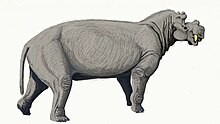Uintatherium
| Uintatherium Temporal range: Eocene,
| |
|---|---|

| |
| Cast, French National Museum of Natural History, Paris | |
| Scientific classification | |
| Domain: | Eukaryota |
| Kingdom: | Animalia |
| Phylum: | Chordata |
| Class: | Mammalia |
| Order: | †Dinocerata |
| Family: | †Uintatheriidae |
| Subfamily: | †Uintatheriinae |
| Genus: | †Uintatherium Leidy, 1872 |
| Species | |
| |
| Synonyms | |
| |
Uintatherium ("Beast of the Uinta Mountains") is an extinct genus of herbivorous mammal that lived during the Eocene epoch. Two species are currently recognized: U. anceps from the United States during the Early to Middle Eocene and U. insperatus of Middle to Late Eocene China.[1]
Description

Uintatherium was a large browsing animal. With a length of about 4 m (13 ft), a height of 1.70 m (5.6 ft), and a weight up to 2 tonnes, it was similar to today's rhinoceros, both in size and in shape, although they are not closely related.[2] Its legs were robust to sustain the weight of the animal and were equipped with claws.[3] Moreover, a Uintathere's sternum was made up of horizontal segments, unlike today's rhinos, which have compressed vertical segments.[4]
Skull

Its most unusual feature was the skull, which is both large and strongly built, but simultaneously flat and concave: this feature is rare and, apart from some brontotheres, not regularly characteristic of any other known mammal. Its cranial cavity was exceptionally small due the walls of the cranium being exceedingly thick. The weight of the skull was mitigated by numerous sinuses permeating the walls of the cranium, like those in an elephant's skull.
The large upper canine teeth might have served as formidable defensive weapons, and superficially resembled those of saber-toothed cats. Sexually dimorphic, the teeth were larger in males than in females. However, they also might have used them to pluck the aquatic plants from marshes that seem to have comprised their diet.
The skulls of the males bore six prominent knob-like ossicones that grew from the frontal region of the skull. The function of these structures is unknown. They may have been of use in defense and/or sexual display.
Discovery

The fossils of Uintatherium are among the largest and most impressive of the finds at the excavation of Fort Bridger in Wyoming, and were a focal point of the Bone Wars between Othniel Charles Marsh and Edward Drinker Cope. Between them, Marsh and Cope claimed the discovery of U. anceps specimens as discoveries of new species on twenty-two separate occasions (and therefore, originally gave these specimens many different names aside from Uintatherium anceps).[5]
Fossils of U. anceps have been found in the Bridger and Wakashie rock formations, in the states of Wyoming and Utah near the Uinta Mountains, which are commemorated in the generic name. An almost intact skull of U. insperatus was found in the lower part of the Lushi Formation of the Lushi Basin in Henan Province, China.[1]
A cast of a Uintatherium skeleton is on display at the Utah Field House of Natural History State Park. The skeleton of Uintatherium is also on display at the Smithsonian National Museum of Natural History in Washington, DC.[6]
References
- ^ a b Tong, Yongsheng; Wang Jingwen (July 1981). "A SKULL OF UINTATHERIUM FROM HENAN" (PDF). Vertebrata PalAsiatica. XIX (3): 208–214.
- ^ http://www.enchantedlearning.com/subjects/mammals/Iceagemammals.shtml
- ^ Joseph Leidy (1873). "Contribution to the extinct vertebrate fauna of the Western Territories". Geological Survey of the Territories. 1.
{{cite journal}}: Cite has empty unknown parameter:|coauthors=(help) - ^ Restoration of Dinoceras mirabile, de Charles Othniel Marsh
- ^ Bill Bryson, "A Short History Of Nearly Everything", Doubleday (2003).
- ^ http://paleobiology.si.edu/geotime/main/htmlversion/evidence/eoc_02.html
Further reading
- Academy of Natural Sciences
- National Park Service
- Wood, Horace Elmer 1923, The problem of the Uintatherium molars, Bulletin of the American Museum of Natural History ; v. 48, article 18
- Fossil Evidence - Eocene: Smithsonian National Museum of Natural History
